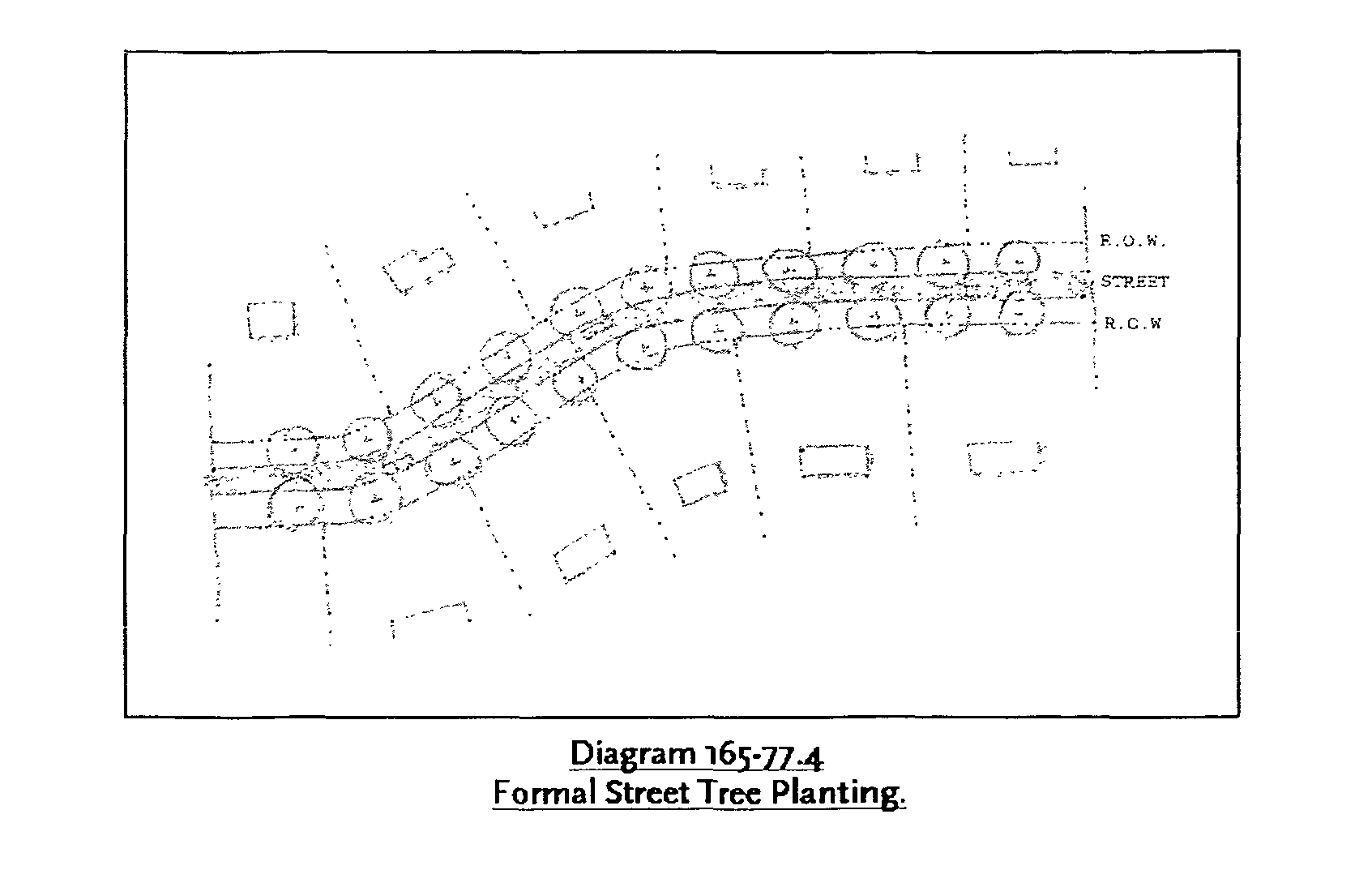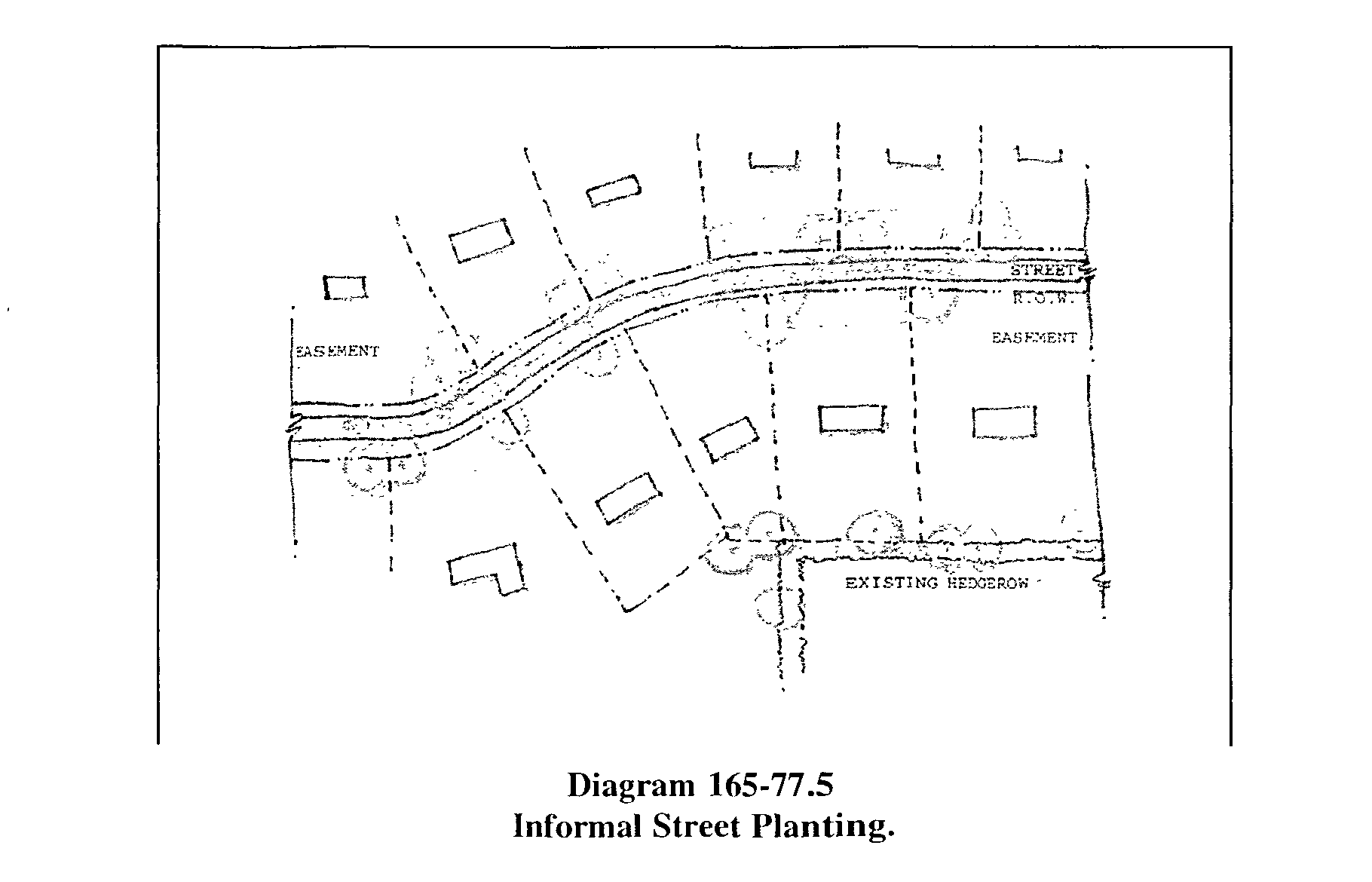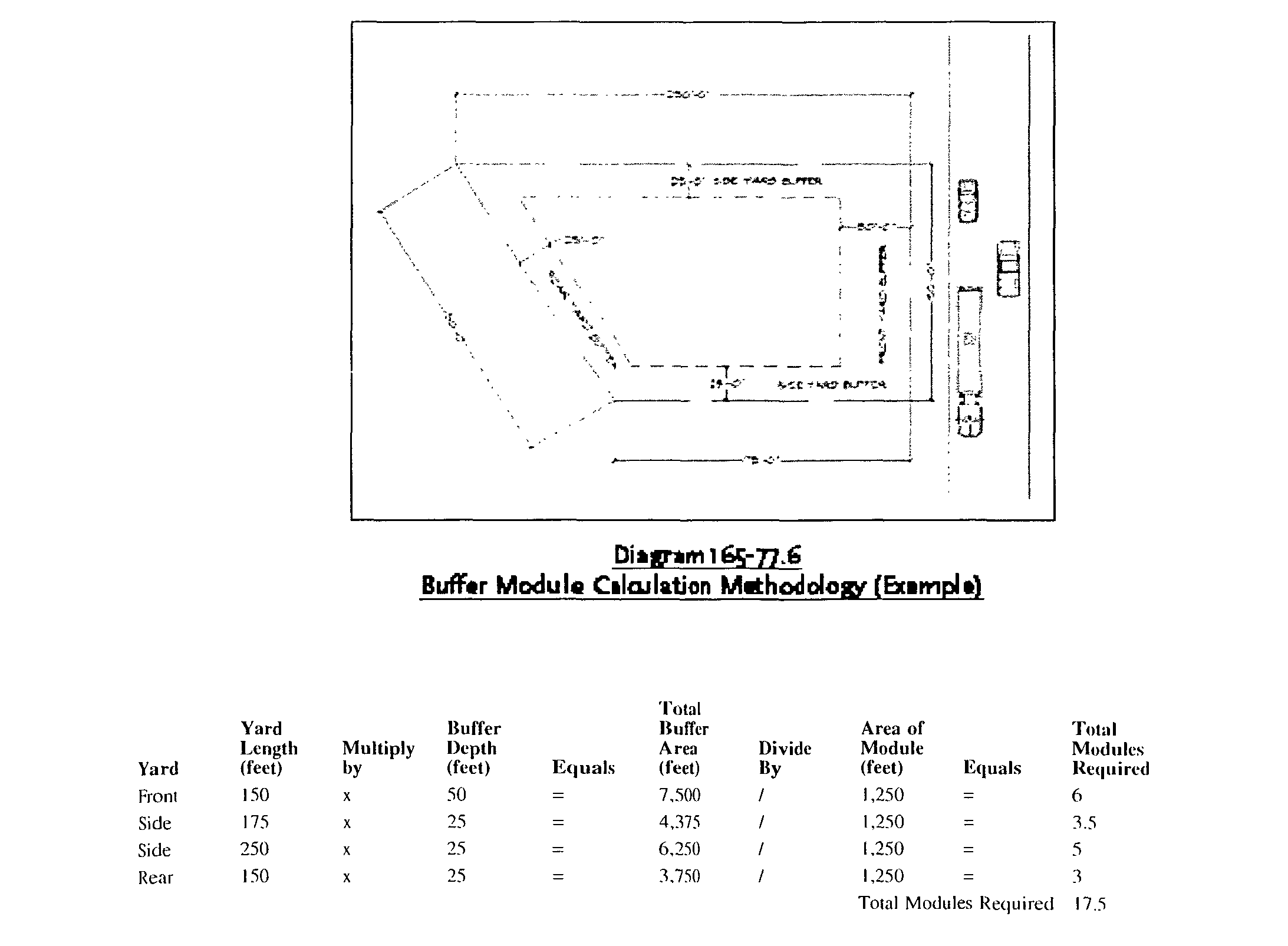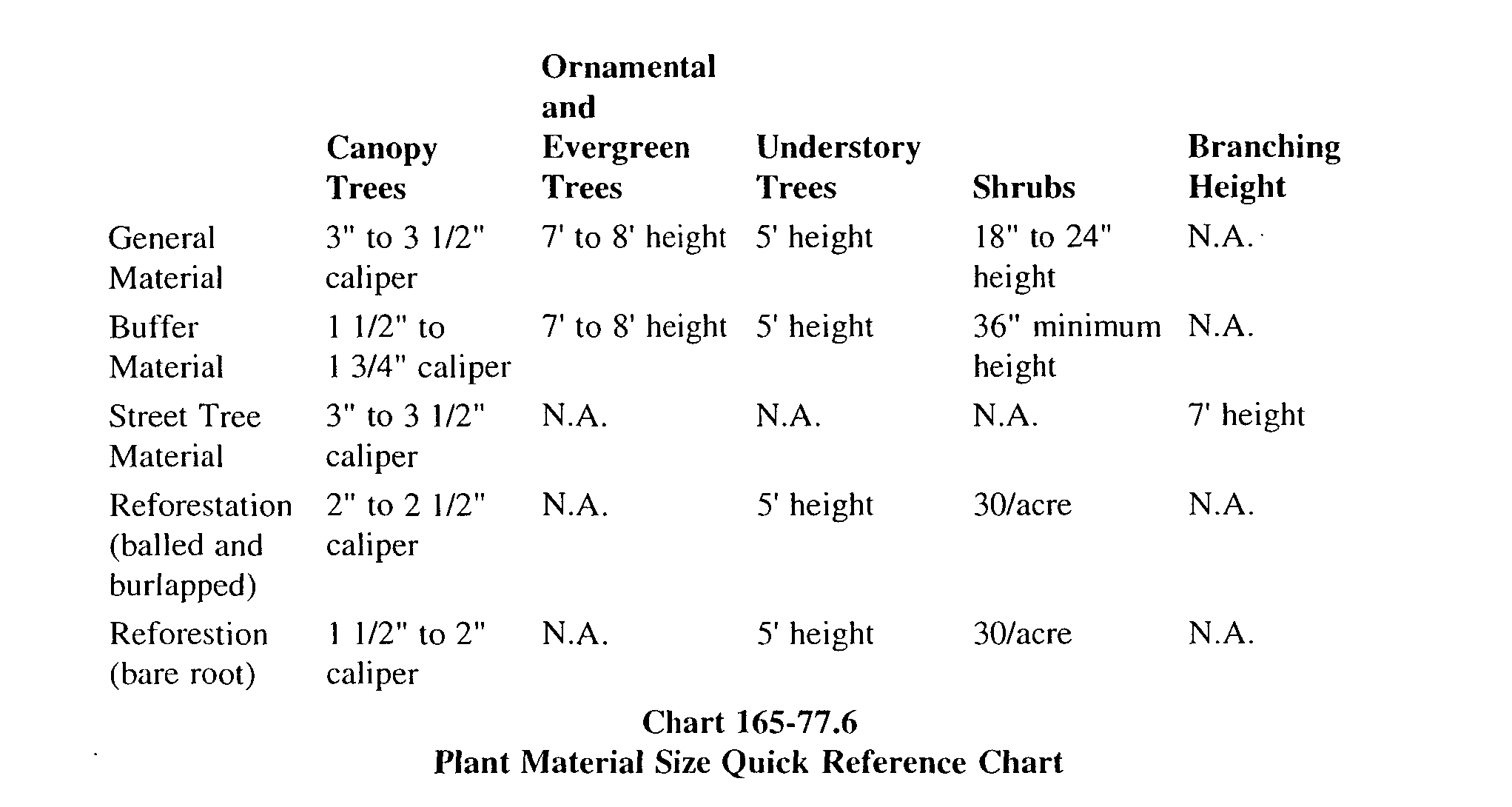
(8) In order to preserve the rural character of a specific site, the board may request an informal street tree planting. Species shall be grouped / massed along roads in such a manner to fit appropriately within the site and shall be placed within a street tree easement. See Diagram 165-77.5.�

I. Screening of utility and wellhead markers.�
(1) Wellheads not located within the building envelope shall be screened from street view.�
(2) Plantings shall screen utility structures, such as transformers, cable, or phone connection points, from the street view.�
J. Water quality facilities.�
(1) The utilization of plant material within a stormwater quality treatment facility is required. Not only does the appropriate plant material aid in the removal of total suspended solids and other non-point source (NPS) pollutants, but also provides visual interruption from the cleared, graded area for the facility. Stormwater retention facilities are excluded from this section, except where specified.�
(2) Plantings shall be included within such facilities. The species selected for such areas shall be tolerant of water inundation and drought conditions and is subject to review by the approving authority, Municipal Landscape Architect and Municipal Engineer.�
�
(3) Detention basins and other similar stormwater management and design facilities shall be screened from the public right-of-way. The landscape plan shall include native grasses, ground cover, trees and shrubs to achieve a buffer that screens 60% of the view from November to April at a height of three feet, two years from installation.�
(4) Creative grading solutions for such facilities shall be considered, to create landforms that blend the facility in with the existing site.�
(5) For every 2,000 square feet of water quality facility area the applicant shall provide three canopy trees, five evergreen/ornamental/understory trees and 20 shrubs consistent with the size requirements set forth in the reforestation requirements.�
(6) Planting of woody shrubs and trees shall not be located on top of any dam structures.�
(7) Maintenance protocol of such structures shall be in accordance with best management practices.�
(8) If retaining walls are necessary, such walls shall have plantings on top and/or below to provide a visual screen of the wall.�
(a) Screening shall include native grasses, ground cover, trees and shrubs to achieve a buffer that screens 60% of the view from November to April at a height of three feet, two years from installation.�
(9) Stormwater retention facilities.�
(a) The stormwater retention facilities should be designed in such a way to benefit from the aesthetic as well as the physical attributes. Such facility shall be utilized as decorative water features within the landscape.�
(b) The water's edge shall, be planted with native vegetation at a minimum height of 30 inches to deter geese and promote biodiversity within such an ecosystem.�
K. Buffering of neighboring lands.�
(1) Buffer required. All subdivision and site plan applications subject to this section (§ 165-77) shall require a planted perimeter buffer as part of the development and landscape design plan. The perimeter buffer shall be provided along existing streets and along property lines adjacent to the subject property. The buffer shall consist of, for example, fencing, evergreens, canopy trees and shrubs to serve the purpose of maintaining the appearance of a rural and agricultural community.�
(2) The goal of the following buffer standards is to maintain and/or re-establish the traditional rural boundaries of tree lines, hedgerows walls and fences.�
�
(3) Buffers shall screen 60% of the view from November to April at a height of six feet within two years from installation.�
(4) On forested parcels, a minimum undisturbed buffer with a depth of 30 feet shall be maintained. Supplemental plantings may be required to fill in visual gaps in the buffer.�
(5) On agricultural or other cleared parcels, a minimum buffer with a depth of 30 feet shall be established, consisting of tree lines, hedgerows, fences and walls. For each 50 feet of buffer length, the plan shall include the following: shrubs, walls or fences to provide a visual screen at least four feet high; eight ornamental/understory trees, including deciduous and evergreen species; and two canopy trees.�
(6) Properties adjoining agricultural lands shall have one permanent sign affixed not less than at each property corner, and one additional sign for every 100 feet of common property line, the area of the sign not to exceed two square feet, which shall be lettered as follows:�
NO TRESPASSING!�
ENTRY ONTO FARMLAND OR THE DUMPING OR DISPOSAL OF HOUSEHOLD, LAWN OR GARDEN DEBRIS IS SUBJECT TO FINE OR IMPRISONMENT.�
(7) Nonresidential site plans shall comply with the following standards, in addition to those above:�
(a) Front yard buffers:�
[1] C-1, C-2, OB-1, and ROM-3 Districts: 50 feet.�
[2] ROM-1, ROM-2, and PDO Districts: 100 feet.�
(b) Buffer where a nonresidential use abuts another nonresidential use: 25 feet.�
(c) Buffer where nonresidential uses abut a residential use along a side or a rear lot line:�
[1] C-l, C-2, OB-1, and ROM-3 Districts: 50 feet.�
[2] ROM-1, ROM-2, and PDO Districts: 100 feet.�
(8) Planned development shall comply with the following additional landscape design standards:�
(a) A buffer zone of at least 50 feet shall be maintained along the perimeter of any planned development tract. Where development other than one-family detached dwellings in a planned development adjoins a residential zone, said buffer zone shall be at least 100 feet. Said buffer zone shall be kept in its natural state when wooded, and, when natural vegetation is sparse or nonexistent, a planted visual screen, which may include mounding of earth and other landscaping measures, may be required unless topographic features render such landscaping measures unnecessary.�
(b) Within said buffer zone, no principal or accessory structure, nor any off-street parking or loading areas or other uses, shall be permitted. Within said buffer zone, utility easements may be permitted. Drainage installations, such as detention and retention basins, may also be permitted, provided that they are located at least 50 feet from the planned development tract boundary. Streets shall be allowed only to cross buffer zones and only when necessary to provide connections to existing public streets or when needed to ensure continuity with development of adjoining property.�
(c) Said buffer zone may be included for the purpose of computing the planned development open space requirements.�
(d) The buffer zone requirements may be reduced or eliminated by the approving authority where planned developments abut or where the planned development is consistent and compatible with adjoining uses.�
(9) Plantings may consist of those listed on the Township's Official List of Plants, pursuant to § 165-77F.�
L. Buffer landscape design.�
(1) Buffers separate and create enclosure of particular uses and zones within the community. Landscaped buffers are crucial to maintaining the diversity within the Township.�
(2) All plans and installation of plant material are subject to review and inspection by the Municipal Landscape Architect.�
(3) Where plant materials are placed in two or more rows, plantings shall be staggered from row to row.�
(4) The percentage of evergreen usage should be decided after completion of site analysis and the statement of design goals.�
(5) The standard design buffer module measures 50 feet long by 25 feet wide, which consists of 1,250 square feet. This module shall be repeated as many times as necessary to fulfill the depth requirements for each zone and be in addition to any other planting requirements. See § 165-77 for the buffer size requirements. See Diagram 165-77.5 for calculation methodology.�
(6) Each buffer module requires three canopy trees, five under story/evergreen trees and 20 shrubs. Species selection should be based on an appropriate woodland successional model, and may consist of those listed on the Township's Official List of Plants, pursuant to § 165-77F.�
(7) Rather than specify a modular design to be used on each design proposal, the following plant material density for a hypothetical fifty-foot-long by twenty-five-foot-wide module which could be repeated as many times as necessary both in length and width (e.g., a site with a highway frontage of 500 feet and a one-hundred-foot-wide buffer requirement would need 40 modules). The plant material requirements of these modules may be arranged to suit the specific landscape design objectives of the proposed plan.�


(8) In this example, the applicant will need to provide 59 canopy trees, 98 understory/evergreen trees and 390 shrubs to meet the requirements set forth in the buffer section of this section. .�
(9) Landscape buffers that are interrupted by specific site constraints relating to engineering components, such as septic, fire suppression and sight triangle, shall relocate the materials slated for those areas to another area on site.�
(10) Within Clinton Township, the linear, less formal hedgerow seen commonly bounding cropland, fields and pastures is often a more suitable model for plantings along lot lines and streets and highways transversing such landscapes. In every effort to minimize disturbance and preserve the existing flora within these natural occurring buffers, the applicant may utilize existing material, slated to be preserved, to meet the buffer requirements as deemed appropriate by the board, approving authority and the Municipal Landscape Architect. In the event existing vegetation cannot be preserved, the applicant shall provide the appropriate tree replacement in addition to the buffer requirements.�
(11) Though material adjacent to the applicant's particular site may help with buffering, only material on the applicant's site shall be utilized in evaluating the buffer module requirements.�
M. Planting and maintenance.�
(1) All plant material shall be insect and disease-free and in good condition at time of planting.�
(2) The selection, spacing and sizing of plant materials shall depend on the use to which the plantings are placed in keeping with the specifications adopted by the approving authority.�
(3) All plantings shall be planted according to sound horticultural practices as established by the Rutgers' Cooperative Extension Service, and shall be in a healthy, growing condition at installation.�
(4) The specific planting dates and transplanting dates, determined by the appropriate time of year and weather conditions, and subject to approval by the Municipal Landscape Architect.�
�
(5) A mixture of plant materials (evergreen and deciduous trees and shrubs) is required as a protective measure against disease and insect infestation. The landscape plan may allow plant materials to be used together in informal groupings in lieu of meeting the on-center spacing requirements set forth on the approved plan. However, the plant groupings must utilize the same slumber of plantings as required by these provisions.�
(6) An irrigation system may be used to establish plant material and sustain adequate moisture needs. All automatic irrigation systems shall be tirner-controlled and provided with an automatic rainfall shutoff detection device. Proposed irrigation systems shall include maintenance specifications on the approved landscape plan.�
(7) Plant materials, except creeping vine-type-plantings, shall not be located within four feet of property lines nor within any right-of-way.�
(8) Planting details and specification shall follow the most recent version of the Clinton Township Planting Details. All material shall conform to the latest version of the American Standard for Nursery Stock.�
(9) Soil conditions should be renovated if necessary to improve growing conditions.�
(10) No planting shall be installed unless it has been subject to proper root and top pruning (top pruning for shrubs only); proper timing (nursery stock must be dormant when planted); proper soil mix (based on the site and species); proper support; and proper maintenance.�
(11) Plants native to the physiographic province in which the site lies should comprise a minimum of 70% of the total number of plants proposed for installation.�
(12) All proposed tree material shall be balled and burlapped except for the reforestation option to use bare-root material. Container material is acceptable for shrub material only, provided that the material is not root bound.�
(a) All bare-root tree plantings shall be at the discretion of the Municipal Landscape Architect and as required by the American Standard for Nursery Stock.�
(b) No bare-root planting shall be installed unless it has been subject to proper root and top pruning (top pruning for shrubs only); proper timing (nursery stock must be dormant when planted); proper soil mix (based on the site and species); proper support; and proper maintenance.�
(13) A deer deterrent/protection wrap shall be installed on the trunks of trees. Tree protection such as Tree Bark Protectors BG48 by A.M. Leonard Horticultural Supply or its approved equal shall be utilized on shade, ornamental and understory trees.�
(14) Where turf is utilized, the type and mix of seed and the preparation method used shall be identified. Within the areas of lawn, mulching type, fertilizing, liming and watering specifications shall be specified. The use of natural and/or organic fertilizers is encouraged. The proposed sod shall be germinated in similar soil composition and characteristics as the soil existing on-site.�
(15) All areas of planting beds to receive mulch shall specify the depth and type of mulch.�
(a) Depth of mulch within planted areas shall be two inches.�
(b) Mulch shall never come in contact with the root flare or trunk of the tree and shrub.�
(c) Shredded hardwood mulch shall not contain any color or dying agent.�
(d) See the Clinton Township Planting Details for further specification. All material shall conform to the latest version of the American Standard for Nursery Stock.�
(16) Planting sizes.�

(17) Landscape maintenance.�
(a) All plantings shall be maintained in an attractive and presentable condition free of weeds, refuse and debris, and shall be continuously maintained in a sound health and vigorous growing condition, free of plant disease and insects, per the final landscape plan.�
(b) The landscape is to be permanently maintained. All dead, diseased, missing plant material is to be replaced to the approval of the Township Landscape Architect. Such replacements shall be resolved within four weeks from time of notification, weather permitting.�
(c) Landscape maintenance specifications shall be submitted as part of the submission set for all common areas. Such specifications shall be detailed to ultimately determine if the proposed landscape is going to be cared for after all guarantees are inet by the developer.�
(d) The approved landscape plan shall designate the person or entity that shall be responsible for maintaining the landscape in a healthy growing condition. Such maintenance shall include watering, cultivation and weed control.�
In the case of a planned development, the developer shall provide for an organization for the ownership and maintenance of any open space for the benefit of owners or residents of the development.�
Such organization shall not be dissolved and shall not dispose of any open space, by sale or otherwise, except to an organization conceived and established to own and maintain the open space for the benefit of such development, and thereafter such organization shall not be dissolved nor dispose of any of its open space without first offering to dedicate the same to the Township.�
In the event that such organization shall fail to maintain the open space in reasonable order and condition, the governing body may serve written notice upon such organization or upon the owners of the development, setting forth the manner in which the organization has failed to maintain the open space in reasonable condition, and said notice shall include a demand that such deficiencies of maintenance be cured within 35 days thereof and shall state the date and place of a hearing thereon, which shall be held within 15 days of the notice. At such hearing, the governing body may modify the terms of the original notice as to deficiencies and may give a reasonable extension of time, not to exceed 65 days, within which they shall be cured. If the deficiencies set forth in the original notice or in the modification thereof shall not be cured within said 35 days or any permitted extension thereof, the governing body, in order to preserve the open space and maintain the same for a period of one year, may enter upon and maintain such land. Said entry and maintenance shall not vest in the public any rights to use the open space except when the same is voluntarily dedicated to the public by the owners. Before the expiration of said year, the governing body shall, upon its initiative or upon the request of the organization theretofore responsible for the maintenance of the open space, call a public hearing upon 15 days' written notice to such organization and to the owners of the development, to be held by the governing body, at which hearing such organization and the owners of the development shall show cause why such maintenance by the municipality shall not, at the election of the municipality, continue for a succeeding year. If the governing body shall determine that such organization is ready and able to maintain said open space in reasonable condition, the municipality shall cease to maintain said open space at the end of said year. If the governing body shall determine that such organization is not ready and able to maintain said open space in a reasonable condition, the municipality may, in its discretion, continue to maintain said open space during the next succeeding year, subject to a similar hearing and determination in each year thereafter. The decision of the governing body in any such case shall constitute a final administrative decision, subject to judicial review.�
The cost of such maintenance by the municipality shall be assessed pro rata against the properties within the development that have a right of enjoyment of the open space in accordance with assessed value at the time of imposition of the lien and shall become a lien and -tax on said properties and be added to and be a part of the taxes to be levied and assessed thereon and shall be enforced and collected with interest by the same officers and in the same manner as other taxes.�